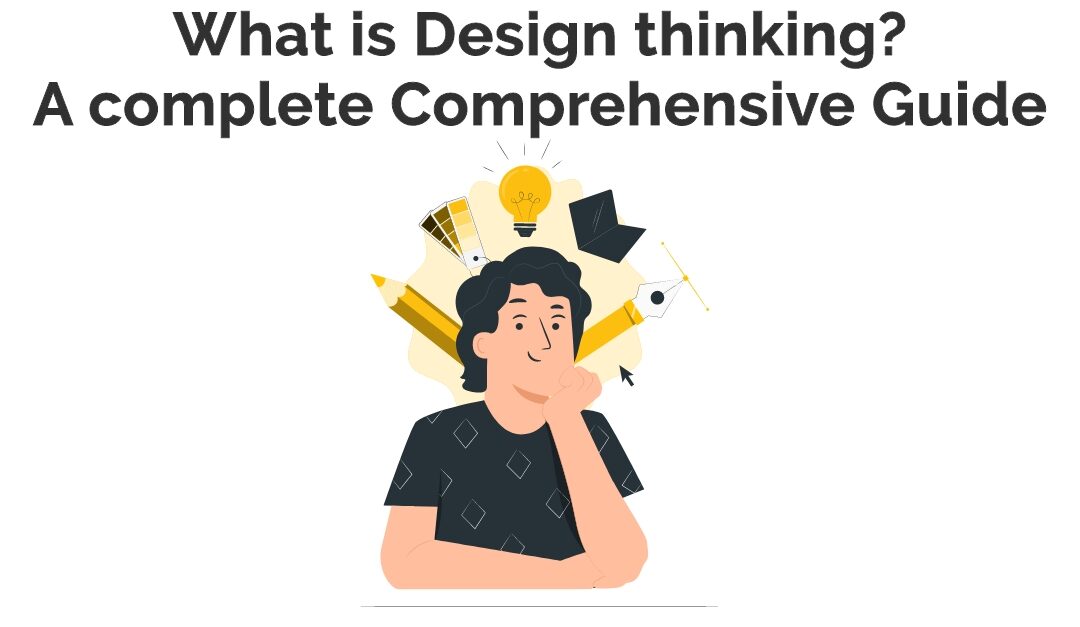Design Thinking Definition
Design thinking is very influential in the current time. Many leading companies adopt this process in their brands, such as Apple, Google, Samsung, GE, and many others.
It is an iterative method where designers endeavor to interpret the user, challenge theories, and reformulate complexities. They analyze alternative practices and solutions that are not immediately possible with our primary level of understanding. It gives a solution-based approach for dealing with problems with thinking, working, and several hands-on methods.
There is vast engagement in awareness of users for whom we design the products or services. It assists UX designers in recognizing and generating empathy with the target user and also helps in questioning the problem, assumptions, and implications. DT is useful in forcing points that are ill-represented or unknown by reshaping in human-centric ways.
They are planning multiple ideas in brainstorming sessions and using various concepts in prototyping and testing. It includes current experimentation, such as sketching, prototyping, testing, and working out approaches and opinions.
Schedule Your 30 Minutes FREE Consultation
Design Thinking Process
It is adaptable, non-linear, letting UI UX designers go back and forth within ideation, testing, and user definition as best suits the project.Nowadays, there are various variants of the design thinking process in use. There are three to seven phases of the thinking model in use & all these exceptions show related principles. They based most of all exceptions on the doctrines of Herbert Simon.
Here, we focus on the five stages of the model suggested by the Hasso -Plattner Institute of Design
Let us discuss five design thinking steps:
Empathize
The first stage of this method is to build up an empathic opinion of the problem by working on it to figure it out. It includes discussing specialists to find out more about the state of interest by inspecting, engaging, and empathizing with people. It interprets skills, desires that engaging in the bodily context to get a result of the concerned problems.
Empathy is essential in a human-centered design manner, enables design thinkers to insert their expectations about the world to understand users’ needs.
UX designers depend on time to accumulate a sufficient volume of information for us through the next stage. It reveals the perfect opinion of the users, their requirements, issues that determine the growth of a specific product.
Define
In the Define stage, we simultaneously set the information that is generated & collected during the Empathize stage. UI/UX designer agency interprets experiences and also integrates them to explain the root issues up to this point. They endeavor to explain the problem as a problem record in a human-centered manner.
The Define stage helps the designers in their team to collect exceptional ideas to set features, functions, and other factors to solve the problems. The users can fix issues themselves with minimal complexity.
In the Define stage, they emerge to the third stage Ideate, by inquiring questions for solutions.
Ideate
In the third stage of the design thinking process, designers are eager to generate ideas. They understand users’ requirements in the Empathize stage, analyze and synthesize notes in the Define stage, and conclude with a human-centered explanation.
They help team members of the designer team to start with creative ideas. It supports analyzing unique solutions to the problem & look for multiple methods of examining the issue.
There are several Ideation methods, such as Brainwrite, Brainstorm, Worst Possible Idea, and SCAMPER. Brainstorm & Worst Possible Idea concourses are used for exciting free-thinking to extend the problem space.
It is essential to get multiple ideas or problem solutions as likely at the start of the Ideation phase. They select various Ideation methods by the end of the Ideation stage to examine and analyze ideas. It helps to identify the reliable way to solve a query or present the involved factors to dodge it.
Prototype
The UX designer team provides several modest, scaled-down modifications of the product or unique features. They examine the problem explanations formed in the preceding stage and also share prototypes tests on the team. It is an exploratory step to recognize the best viable solution for each of the problems perceived in the first three stages.
They create answers within the prototype to investigate one by one so they accept, update, re-examined, or reject based on the user’s experiences.
UI UX design team has a reliable idea of the captivity essential to the product & problems. They present with a clear view to know when interacting with the product end.
Test
Designers thoroughly test the concluded product using the best solutions recognized through the prototyping phase. It is the ultimate stage of the 5 stage model, in an iterative method to generate the results in the testing phase to reconsider various problems.
They enlighten with the knowledge of the users, the circumstances of use, to think, perform, and respond, to empathize. In this phase, they made clarifications, modifications, and ruled out solutions to develop a deep consciousness of the product and its users.
It is crucial to know that the five stages are not regularly following any specific order. They usually appear in similarity and iteratively. We know the stages as various processes to lead a project, then following steps.
The surprising thing about the five-stage of the DT process is that it includes activities specific to the product. We used both information to update the conclusion of the problem and solution areas to redefine the problems.
It helps designers to set up a constant mind to gain advanced insights. They generate modern ways of viewing uses of the product & set up a deep understanding of the users.
Implement
The most important part is the implementation of all steps. Here we ensure all solutions are strengthened & influence the lives of users. DT is not free from the actual design.
The progress of the thinking process exists in its capability to convert a view of the end user’s life. In this process, the sixth step is very effective because it is the opinion of all raised steps. It is getting an idea in your head and converting that idea into an actual object.
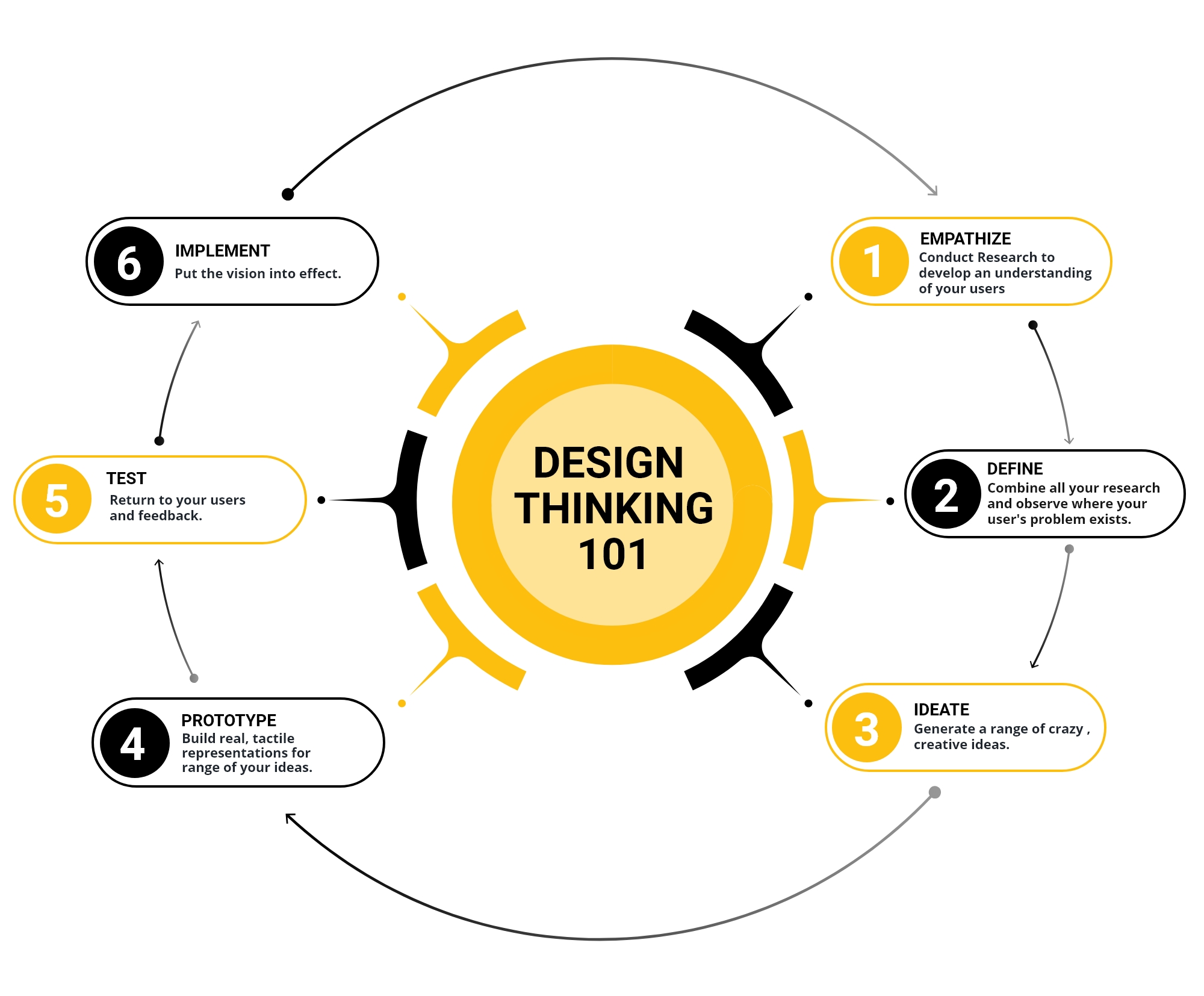
Think Out Of The Box
We refer to the thinking process as outside-the-box thinking. Designers are striving to advance ways of thinking through direct, simple problem-solving methods.
It is the plan to enhance products by analyzing how users connect with products by reviewing the conditions.
The crucial factor of creative thinking is to distort past assumptions to make it probable to prove whether they are valid.
The solution-generation method helps to design ideas that show the real constraints and facets of a specific problem.
Design Thinking Methodology
The stages of design thinking undertake to solve actual issues practically, with a significant strength of human requirements and possibilities. Design thinking methods and tools concentrated on the user or the customer.
There are many risks and vagueness connected with an innovative human-centric approach.UI UX design agency linked with the user from a starting, & presenting them an essential part of the means. The thinking process follows various methodologies or approaches & all of them manage the human-centric approach.
There are multiple approaches. Let us check primary methods of the thinking process of designing.
4D
It separates the thinking process into four stages as Discover, Design, Develop, and Deploy. UX designer starts with analyzing the problem, moves it to the drawing board, starts developing, and finally, sets into action in the last stage.
Double Diamond
The double diamond method is like the 4D strategy, which explains its steps as Discover, Define, Develop and Deliver. When they started working on this first, several solutions are proposed based on the user’s needs & their priority areas.
Designers practice prototyping on the priorities recognized in the previous stage. They addressed the pressures and limitations in finalizing the most proper explanation.
5D
It is a mixture of 4D and double diamond design processes. This method enables entry during any stage of the product or service design process.
Deep-Dive
It is a blend of brainstorming, prototyping, and feedback that allows designers to generate solutions for various business-related issues and tasks. This is more a tool than a method.
It has multiple stages, such as understanding, observing, visualizing, evaluating, refining and implementing. In the first step, they learn needs, captivity, problem areas of the products and services. After this, they recognized demands in the real-world setting & tested unique solutions, and marketed them in the last step.
Stage-Gate
This method concentrates on the commercial perspective of presenting an idea or solution to a product or service. It is like a roadmap that leads the designers and decision-makers through the method of ideation to production. Gates or checkpoints are at crucial locations to check growth or profit methods. The specific management authorities protected these checkpoints & concluded whether the project continues or withdrawn.
Pentathlon
It is one of the most effective methodologies in the thinking process of design. It provides particular priority to the communication with the designers in the design process of thinking.
Simon Herbert
This method has seven various stages. We have defined it as research, ideate, prototype, objectives, implement and learn. They recognized it as a non-iterative process.
Bootcamp Bootleg
The Stanford d.school formed one of the most distinctive methodologies. It describes its moves as Empathize, Define, Ideate, Prototype, and Test. Empathy is core to the human-centric way of thinking & it is also a non-linear way to design thinking. You move forward or backward on the steps and strengthen throughout the method.
Donut
Donut is a circular & iterative method, also known as the Iterative Design Process Cycle. It starts with the design outline and induces until it arrives at a solution. They divided it into the following stages, problem finding, problem selecting, solution-finding, and selecting.
In-depth research completed in the first step also includes personal observations, literature, and many others. They access problem-solving in the second stage & thoroughly analyze, gather and identify patterns.
In the third stage, the UI UX designer company identifies & prioritizes user needs. The tools or products are built and tested in the last phase that meets the user’s needs and solutions to recognized problems.
Stuart Pugh
It is a combination of circular and linear design thinking methodology. It is more suitable for core-based models and engineering problems. These are steps iteration, testing, and evaluation included in this model and design activities.
Circular Chaos
It is circular and iterative and also includes company communication within the circle or environment and people outside. This circular method enables businesses to set up new and innovative products or services for customers to buy and use them.
Spiral
It is a similar method to the donut or circular chaos method is the Spiral method. It reinforces a gradual process where improvement or refinement of the product takes place step-by-step until it approaches prototyping and product introduction.
Designing For Growth
It is a perfect method that includes a tool in every stage of the design process. It illustrates how the design method narrows down as it develops. In this, designers especially ask four questions: What is? What if? What Wows? and, What Works? These four questions define the design thinking process.
NPD
This method has three versions and embodies all the primary stages of several models identified in design literature. They based it on thorough research that includes interviews, portfolio, and many others.
The NPD method of Ulrich and Eppinger concentrates on costs or estimations during product expansion. Andreasen & Hein’s NPD method includes three specific features in the design process: market, product, and production. The steps of this model are Recognition of the Need, Investigation of the Need, Product Principle, Product Design, Product Preparation, and Execution Phase.
V
The V-Model is known for adding a link between the stages by verification and validation. It represents a uniform method for the design and development of a product or service. It proceeds upwards after the coding to form a unique V-shape.
Waterfall
It is a simple method of design thinking. This model applies to simple, well-defined problems.
These are the primary methods of the design process used in various ways. It helps designers to know all factors about customers and products or services.
Design Thinking Framework
There are many models of design thinking, so it helps to create engaging designs. We quickly explained the value produced by a collaborative design effort. In design processes, there is a design thinking framework for reference to grope for answers.
Business analysts have reinforced the dictum Good design is good business. It means the design is the core of the modernization strategy of companies. Multiple design frameworks outline a collaborative thinking process.
We define a design as a process connected with estheticism. It brings finance, human resources, ideas, or tech experts to get a maximum target in the critical thinking phase. It strives to follow a linear set of steps and tools so the designer concentrates on identifying answers. The primary hypothesis quickly expands the range and enables the capture of various ideas for an outcome.
Design thinking framework follows the underlying ideology of its various businesses, seeking to gain a collective concept for their customers.
Let us discuss the primary DT framework process.
IDEO
This framework became famous when IDEO’s Tim Brown published their test book. He provides a framework based on the human-centric design on industrialization and social innovation. They give importance to the principles of Viability (business), Desirability (human), and Feasibility (technical). IDEO’s model is constantly observed as a traditional design thinking process.
It is necessary to think like a designer who converts the process teams to develop products, services, processes, and strategies. According to IDEO, DT brings what is preferable from a human point of way that is technologically workable and economically viable.
It allows people to use creative tools to address a vast range of challenges. They consider design to as a human process described with active association and experience of people. It holds a combined way of thinking as a process & system of overlapping areas, preferably of an orderly series of activities, varying the framework into three spaces: inspiration, ideation, and implementation.
In the inspiration phase, designers refine their ideas into visions from on-field studies and design research planned on human behaviors that lead to concrete solutions. In the ideation phase, various groups of people engaged to create skills and test contending ideas on the insights for the inspiration phase.
In the implementation phase, they generate the ideas to transform positive concepts into prototypes. They convert ideas into original products or services to be iterated and refined. The prototyping method tries to uncover surprising implementation difficulties and consequences. It is a sharp-sighted form of DT by IDEO that is prominent and developed by many in the industry.
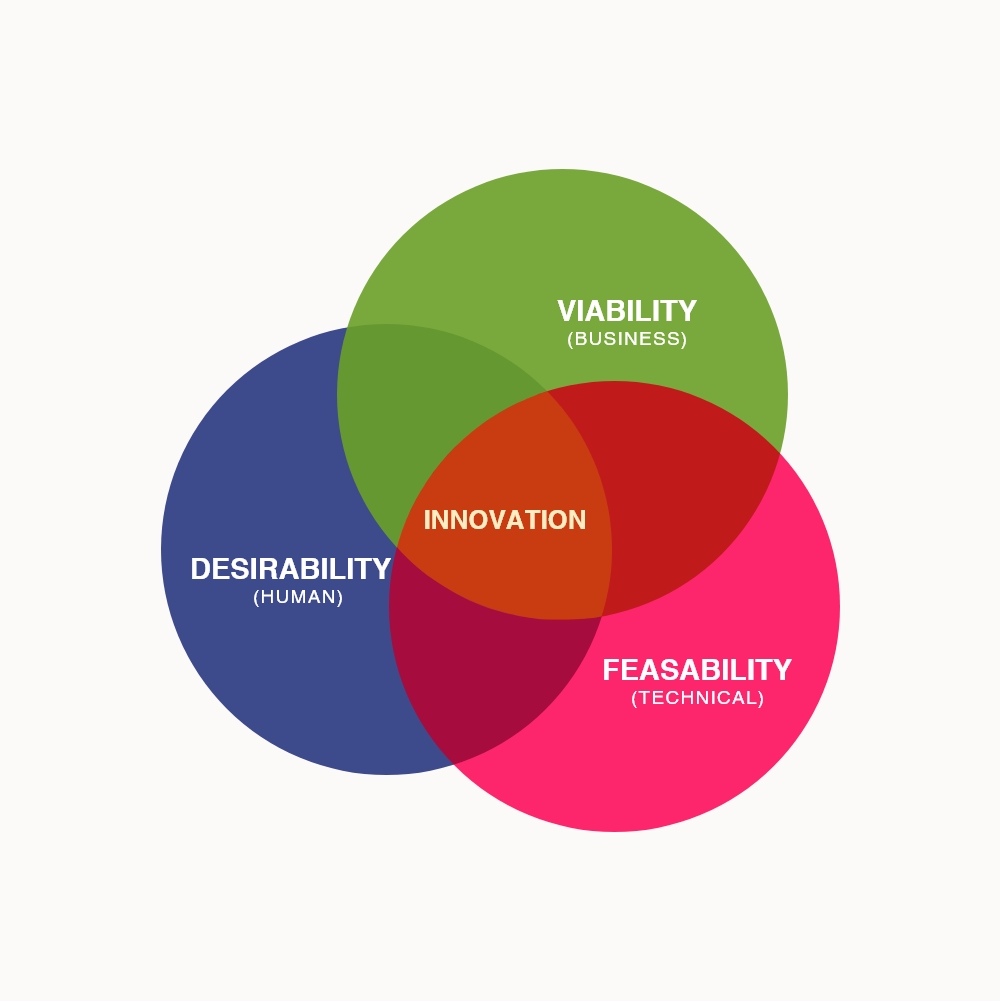
Hasso Plattner Institute of Design
We have also known the Hasso Plattner Institute of Design at Stanford as the Stanford d.school. David Kelley, IDEO’s co-founder & an electrical engineering professor at Stanford found it, along with other professors in 2004.
The d.school provides programs intending to bring students collectively from Stanford University and business leaders from the industry. They analyzed their productive confidence and its DT framework as a 5-level journey. They use these in their searching design projects also uses in their projects. The main stages are:
Empathize
In this phase, a team of designers controls information and interview activities. They empathize with the presence to discover unmet user requirements.
Define
When they gain a good quantity of empathy from following or interviewing users, they assist teams in collecting stories of the current tasks. They involve the user description and a vision that is saved in the first phase.
Ideate
In this phase, the current brainstorming solutions start. They reframe the problem based on the preceding two stages and deliberate on the opportunities to change thinking. There are procedures to use reasonable explanations in encouraging more ideas.
Prototype
It is nearly designing a minimum viable product (MVP) and catching the basics of experience, interactions, and many others. In this stage, they develop a concrete solution to focus on the customer’s needs.
Test
It is the best time to examine prototypes with customers to get a direct assessment of the information. It is a section of the fail fast fail strategy in creating user-centric products.
The Stanford d.school framework works on the five-level and based their searches on this.
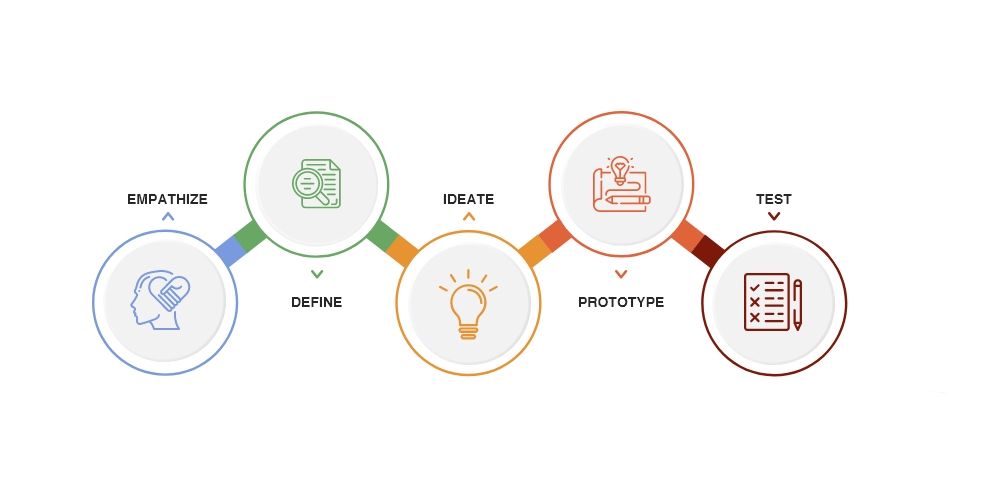
Idea Couture
Idea Couture’s (IC) DT framework, a strategic design firm, carries an organized way. They connect DT with future thinking and apply the method to produce a business strategy for customer experience.
They develop a strategy called IMPACT a Foresight Game for understanding the essentials of necessary foresight thinking. Idea Couture’s DT framework is gained from market research and analysis relating to storytelling & observational research. They explain customer requirements for handling the inputs into images through rapid prototyping.
IC has marked its specific framework as D-School + B-School, an approach that unites the integrative skills of design schools with the strategic & analytical thinking of business schools. In receiving a classic technique for generating business advantage for its customers.
DT framework of Idea Couture joins the handling of System Thinking, Business Strategy, and Design. It mixes Futures Thinking to establish a sense of a future market for customer experience.
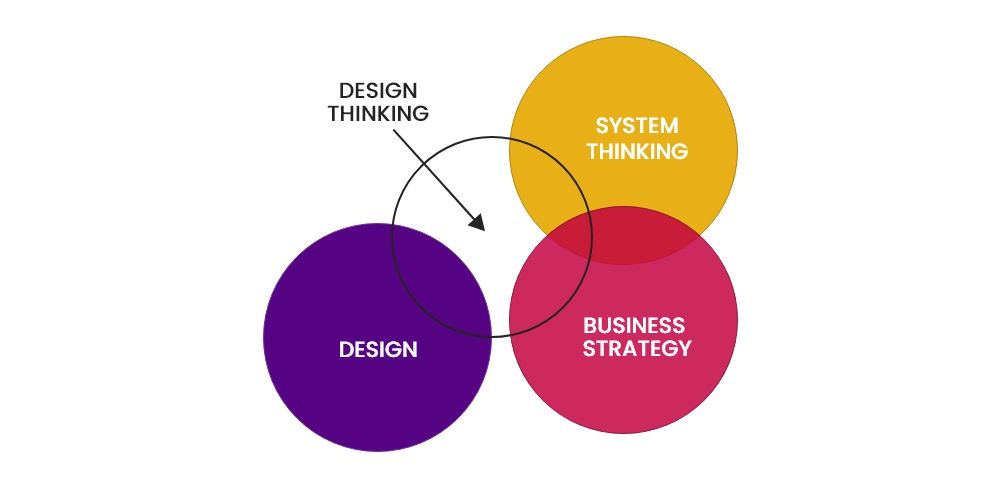
Frog Design
It is an impressive DT method that fluidly supports the analysis of ideas in a nonlinear fashion. We know this framework as the Collective Action Toolkit or CAT and it creates various groups of people to fulfill a shared vision. It becomes unique with its hypothesis that teams start with a striking point of view. Their goals vary each time to learn and develop from an activity.
The associates revisit the to clarify existing at the center of the CAT model, which recognizes the team to express the shared vision and insights. Interpreting CAT’s non-linear tactics, each phase ends with current goals associated with the underlying idea of the project. They outline the framework in 6 steps: Clarify, Build, Seek, Imagine (More Ideas), Make, and Plan. It becomes easy to understand the whole framework.
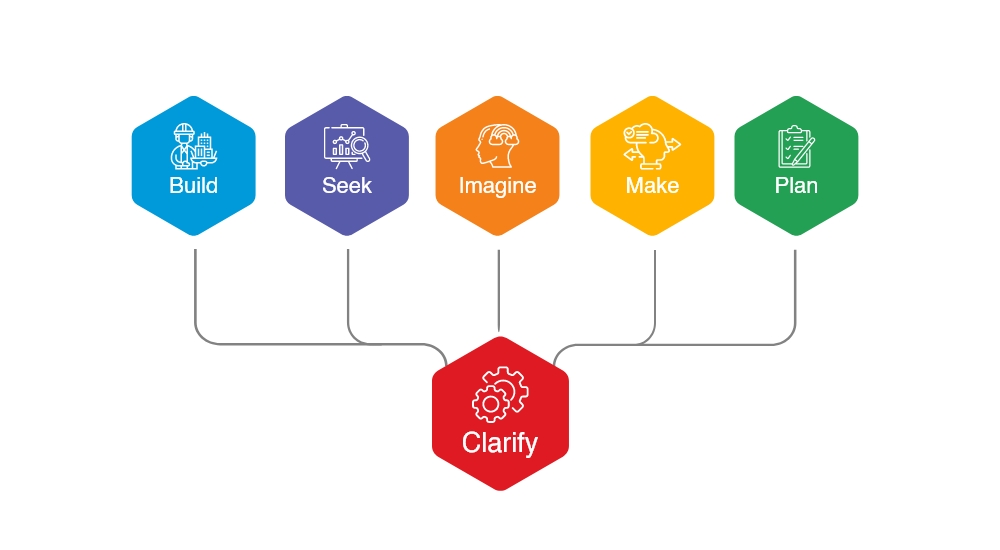
Darden Graduate School of Business
American strategist Jeanne Liedtka promotes a four-phase DT framework, a toolkit for facilitating design managers. They consider themselves like designers in practicing empathy with their customers to set up the structure of business innovation and divide the framework into four categories: What Is?, What if?, What Wows?, and What Works?.
- What Is?
The first phase is a thorough analysis of explaining what is going on today. The resentment that customers experience today is an excellent turning point to create a better future. - What If?
They formed a perception of the existing position of the what-if question, suggesting the opportunity of setting up creative ideas to meet the pain points. The second stage projects begin a series of concepts that capture napkin pitch as a simple description that fits on a paper napkin. - What Wows?
In the third stage, they tested the napkin pitches that were set up in the previous phase using rapid prototyping models. The test to meet customer needs and skills as a team to deal with the growth of a business model produces profitability through developing a sustainable business. - What Works?
In the third stage, they tested the napkin pitches that were set up in the previous phase using rapid prototyping models. The test to meet customer needs and skills as a team to deal with the growth of a business model produces profitability through developing a sustainable business.
There is an active model in the design frameworks throughout this ordering. Both IDEO and Frog have a method that prompted growing visions for social innovation. Stanford’s d.school has a higher linear framework that is easily understandable by beginners and experts.
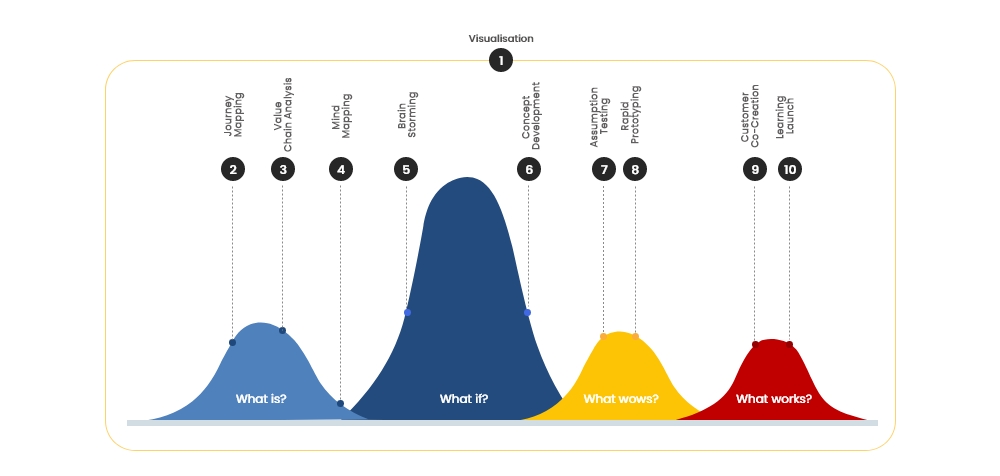
Design Thinking Tool
DT is an attitude or a process of several stages that support various tools to help in the understanding-designing process.There is a list of the best design thinking tools that help to create authentic value for your customers and users. We base it on the various stages of models.
Let us discuss various tools:
Online Tools For Empathize Stage
The initial stage of the DT process is to empathize with users by gathering information with a unique set of tools. It is a human-centered way to focus on the user, preferably on their expectations about a problem.
The tools below help in collecting raw information:
Zoom
When UX designers cannot speak with customers individually or with interviewees, they prefer to conduct video conferences. Zoom presents especially positive quality, reducing audio or video latency problems that people experience with most video conferencing apps.
It has a wide variety of features that are useful for individual and business needs. There are many features, like scheduling calls, a dial-in phone number, recording audio, and video calls with a free service plan.
Typeform
It is helpful for a survey-making world with a straightforward look and an easy-to-use interface. There are also tailor-made options that support designing forms and questionnaires. Its practical alliances also help in saving time and set up replies to arrive in Slack and be recorded in a Google Sheet.
Batterii
It is an appropriate platform for visual thinkers and designers to get on the same page to design their thoughts to produce visually. They browse through the templates, with insight maps and customer journey maps, to analyze stakeholders. The alliances feature to create with users and accumulate insights. It collectively organizes the collected information to support the design process. This tool helps in setting up the material.
Design Thinking Solutions for Define
When information is gathered, their requirements and issues are in the empathizing stage. They analyze and synthesize it to the real problem to recognize problems better. It is appropriate to create personas, establish roles to attach demands & problems to a distinct set of users.
After this, we see what methods develop and outline into one problem statement. Many tools help in analyzing the data. Let us discuss the primary tools.
Smaply
It is a platform to maintain your customer experience, to create, share and present customer journey maps, personas, and stakeholder maps. DT provides a fascinating, comprehensive persona, stakeholder editor that defines the personas for design projects.
Userforge
It helps in creating in-depth & practical personas with fewer clicks to design software. Userforge has fostered teamwork and fast decision to share personas with URLs. It is a free tool that is easy to use, creating usable personas without design skills.
MakeMyPersona
This tool is by Hubspot that helps in architecture the information about personas. It conducts through 19 primary questions that involve the most powerful features to set up personas. They download answers and produce personas in Word form via email. It is the best tool for newcomers to get set up personas.
Tools for Ideate
In this stage, they come with explanations based on the difficulty statement. There is a need to find the best solution with the support of brainstorming and ideation methods.
SessionLab
It is an open library of over 600+ facilitation tools comes a wide variety of ideation methods. There is brainwriting to 3-12-3 brainstorm, to classify the activities to complete workshop templates to arrange ideas circulating in the team. It is free, easy to use by signing up & save favorites or add tools to the library.
Stormboard
It is best to use for managing brainstorming, creating ideas, and prioritizing. You quickly manage sticky notes on various templates to rate and appraise ideas with compelling reporting choices. The other whiteboarding tools as Mural, Miro set with their visual efficiency to encourage creative design work, & highlighted the tools to assist the whole design workflow.
Ideaflip
It is an artistic tool for brainstorming discussions, either with your team or alone. You can add their views on post-it like notes to the virtual area. Ideaflip facilitates discussion and ideas for fast decision-making.
Prototype Apps
There are a few solutions or features in this stage for testing. The primary aim is to set up a prototype that adequately displays a unique character or working mode.
These are easy-to-use mobile apps to turn sketches into animations.
Boards
It strives to create a storyboard toolbox and allows analysis with pictures, gifs, voiceover, and action text or living frames. It is an animation tool to create animation with frames with sounds and cooperate with anyone in real-time.
Mockingbird
It has a clean, user-friendly interface for the best prototyping and wireframe apps. There are many features such as drag-and-drop UI, link several mockups. It has collective and brilliant text resizing with dealing with applied links to make association super easy.
POP
It is a mobile app for adapting sketches into animations by taking ease of your sketches or pictures & merging them into an interactive prototype. The best thing about POP is to share prototypes and get feedback from users.
Platforms For Test
When testing of a product or service is complete or data is earned with testing and redefined with various features.
There are several tools for managing user testing remotely. In case your prototype is a website also benefits from website analytics and screen capture tools.
- UserTesting.com
It is one of the best & biggest names in user testing apps to test whether it is a website or mobile app. It records every step testers exactly understand their navigation to perform the assigned tasks. - Hotjar
It is all-in-one analytics & feedback tool to collect data for funnel transformations and navigation. They are also immediate feedback from users to analyze user problems. - Pingpong
It is a user-research platform to find tens of thousands of testers from around the world. The platform frequently sets up the best testers for you to schedule interviews, also record and analyze.
Tools For Complete Process
Many design thinking tools help apps and online softwares to support the whole design thinking process. It comes in two categories, but the main idea is to provide the best solutions as collaborative online boards.
- Sprintbase
It is a DT software that exceeds & focuses on every step of the design process that is supported by the perfect workflow. It comes from a nonexclusive white-boarding platform to educate users through its tutorials and templates. Sprintbase has a mix of specific software which effectively improves addition skills. - InVision
It reaches a broader field by designing a digital product that does not concentrate on the process. You identify solutions for integrating inspiration, creating information, sharing ideas, sketching, wireframing, and designing prototypes.
Many design thinking tools that help in the thinking process to make them simple.
Wrap Up
UIUX Studio provides services for the last many years, also recognized as the leading UI UX design agency. We are working on various designing projects worldwide. Our designers are experts in their field & know the design thinking process.
We give priority to work according to the latest ways to complete the projects and include all design thinking processes. It helps us in work more perfectly.
Hire UX design agency for multiple designing projects or redesigning websites or apps.
Send your requirement for more details to sales@uiux2.designdevelop3.online
More Resources:
How To Do Effective UX Audit – Step By Step Guide
The Ultimate Guide On DesignOps: Definition, Concept & Steps
Customer Journey Maps: Definition and How To Make One
